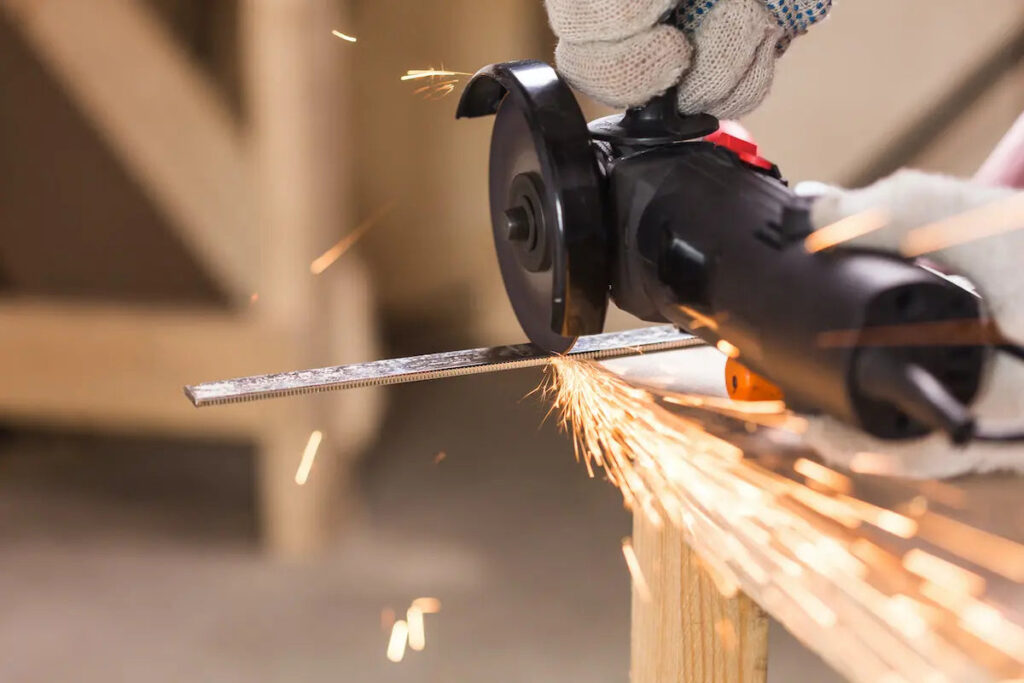Metalworking introduces a realm of challenges and rewards, where achieving accuracy when cutting metal requires a distinct blend of skills and considerations. In this segment, we’ll explore the intricacies of cutting metal with precision, equipping you with the knowledge and techniques necessary for mastery.
Choosing Appropriate Tools
When delving into metalwork, selecting the right tool for the task at hand is of paramount importance. Angle grinders, hacksaws, jigsaws equipped with metal-cutting blades, plasma cutters, and metal shears are the artillery you wield. The choice you make depends on the specific demands of your project and the type of metal you’re working with.
Prioritizing Safety in Metalwork
Metalworking often involves the generation of sparks, flying chips, and the presence of sharp edges. Prioritize your safety by wearing safety goggles, gloves, and appropriate clothing to protect yourself from potential hazards and injury.
Precise Marking and Measuring
A foundation of accuracy, precision begins with your markings. Utilize layout tools, scribes, or even masking tape to meticulously mark your metal before the cutting process commences.
Optimal Cutting Discs or Blades
Diverse metals call for specific cutting discs or blades. Making the right selection is imperative, ensuring that your tools are optimized for clean and effective cuts without undue strain.
Cooling and Lubrication
The act of cutting metal generates heat that can adversely affect your tools and reduce their efficiency. Applying cutting oil or lubricant helps maintain the tool’s temperature, ensuring it stays cool and elevating the quality of each cut you make.
Securing Workpieces and Managing Sparks
Stability is your ally in metalworking. Prevent your workpiece from shifting by securely clamping it in place, preventing unintended movement during the cutting process. When sparks are inevitable, work in a controlled environment, taking necessary precautions to mitigate potential fire hazards.
Refining with Attention to Detail
Post-cut, a thorough inspection is essential. Examine your metal for any rough edges or burrs that might compromise the final product. Should any imperfections be detected, employ deburring tools or sandpaper to attain a polished finish.
Controlling Heat and Pressure
Safeguard the longevity of your tools by controlling heat buildup. Striking a balance between adequate pressure for cutting and preventing excessive heat ensures both effective cutting and tool durability.
Angles and Precision
Just as in woodworking, an intimate understanding of angles is paramount. Whether you’re navigating grain direction, mastering miter cuts, or achieving bevels, meticulous attention to detail will be your guide.
Considering Cutting Angles: Crafting Complexity
In the realm of metalworking, angles play a pivotal role in shaping complexity and enhancing precision. Here, we delve into the art of cutting angles to elevate your craftsmanship.
Grain Direction’s Impact
Similar to wood, grain direction in metal influences the quality of your cuts. Understanding the implications of grain direction empowers you to create accurate and refined results.
The Power of Miter and Bevel Cuts
Mastery of miter and bevel cuts opens a world of possibilities. These techniques grant you the capability to seamlessly craft corners, fashion angled edges, and assemble components with precision.
Navigating Compound Cuts
For intricate endeavors like crafting crown molding or intricate joinery, compound cuts are an indispensable skill. Combining miter and bevel angles enables you to achieve complex designs and structural integrity.
Angles for Effective Joinery
Strong and enduring joints are the cornerstones of metalwork. A profound understanding of angle cuts underpins the creation of joints that stand the test of time, ensuring structural integrity and longevity.
The Importance of Practice
As with any craft, practice refines your technique. Prior to executing cuts on your final materials, practice on scrap materials to hone your skill, fine-tune your approach, and build confidence in your abilities.
General Tips for Success: Elevating Your Craftsmanship
Elevate your craftsmanship to new heights with these essential tips:
- Tools: The Vanguard of Success: Keep your tools sharp and in excellent condition. Well-maintained tools simplify tasks, enhance efficiency, and reduce the risk of accidents.
- Measure Twice, Cut Once: Adhering to this timeless adage saves you from costly errors and unnecessary wastage. Double-check your measurements before executing any cuts.
- Harnessing the Power of Guides: For clean and precise cuts, utilize straightedges or cutting guides. These tools enhance accuracy, ensuring your lines are straight and your results are polished.
- Crafting in a Supportive Space: Raise your workspace for comfort and safeguard your tools and environment from potential harm. Creating a supportive environment enhances both your workflow and the lifespan of your tools.
- Waste Management: Account for the width of the blade or the kerf when measuring cuts to prevent errors in the final product. Attention to detail in measurement preserves the integrity of your work.
- Time and Thoughtfulness: Rushing can lead to costly errors. Dedicate the time required for workspace setup, marking, and tool selection. Thoughtfulness ensures a smooth and productive workflow.
Conclusion: Precision Unveiled
The pursuit of mastering precision in cutting is an art that intertwines knowledge, practice, and unwavering patience. By observing safety protocols, comprehending material properties, selecting the right tools, and refining your techniques, you’ll find yourself achieving unparalleled results in your projects.
Whether you’re sculpting intricate joinery, adorning surfaces with decorative edges, or assembling intricate metal structures, these tips serve as a guiding light through the intricate realm of precision cutting. As you refine your skills, each cut becomes a testament to your craftsmanship.
Embrace the art of precision cutting, for in its practice, you not only create functional and beautiful creations but also cultivate a profound appreciation for the craftsmanship required in every meticulous cut. Your journey into precision cutting has only just begun, and the possibilities are as limitless as your dedication to excellence.








Reader Interactions